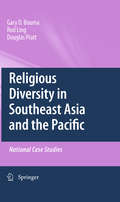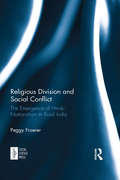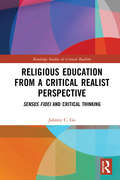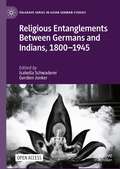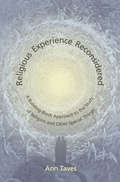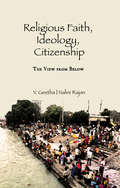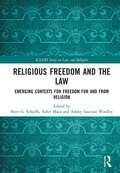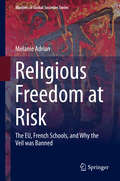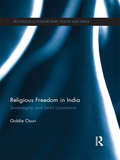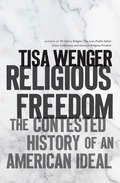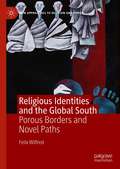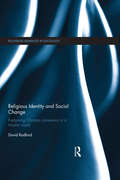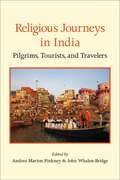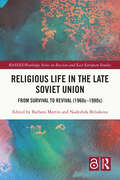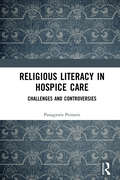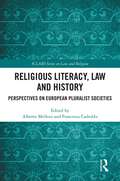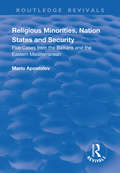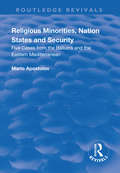- Table View
- List View
Religious Diversity in Post-Secular Societies: Conceptual Foundations, Public Governance and Upcoming Prospects (Boundaries of Religious Freedom: Regulating Religion in Diverse Societies)
by Zakaria Sajir Rafael Ruiz AndrésThis book offers a multidisciplinary exploration of one of the defining characteristics of post-secular societies: religious diversity. Drawing from the sociology of religion, the sociology of migration, and related fields, it critically examines the interaction between religion, diversity, and secular governance, challenging conventional approaches to managing pluralism in contemporary contexts. Organized into three sections, the book explores: Theoretical and Conceptual Foundations: Establishing core frameworks for understanding post-secularization, pluralistic societies, and the intricate dynamics between religion and diversity. Regulating Religion in Postsecular and Diverse Societies: Analyzing policy innovation, comparative case studies, and practical challenges in managing religious diversity within secular governance structures. Navigating the Future: Prospects and Challenges of Diversity Governance in Post-Secular Contexts: Addressing emerging trends such as digital transformations, the politicization of religious identities, and the evolving role of religious traditions in fostering inclusivity and resilience. Featuring contributions from leading scholars and emerging researchers, this volume provides a multidimensional perspective on debates spanning sociology, anthropology, law, and public policy. Through socio-historical examples and case studies, it examines pressing topics such as religious pluralism in secular governance, diversity management strategies, and the transformative impact of digital technologies on religious expression. At its core, the book is framed by two key concepts: post-secularization and diversity. It reexamines religion&’s evolving role in secularized societies, taking religious plurality—not the disappearance of religion—as a starting point for exploring secularity. This work is an essential resource for students, researchers, educators, policymakers, and professionals seeking actionable insights into critical debates on religion, migration, diversity, and secular governance in today&’s globalized and digitalized world.
Religious Diversity in Southeast Asia and the Pacific
by Gary D. Bouma Rodney Ling Douglas PrattReligious diversity is now a social fact in most countries of the world. While reports of the impact of religious diversity on Europe and North America are reasonably well-known, the ways in which Southeast Asia and Asia Pacific are religiously diverse and the ways this diversity has been managed are not. This book addresses this lack of information about one of the largest and most diverse regions of the world. It describes the religious diversity of 27 nations, as large and complex as Indonesia and as small as Tuvalu, outlining the current issues and the basic policy approaches to religious diversity. Southeast Asia and the Pacific Islands are portrayed as a living laboratory of various religious blends, with a wide variance of histories and many different approaches to managing religious diversity. While interesting in their own right, a study of these nations provides a wealth of case studies of diversity management - most of them stories of success and inclusion.
Religious Division and Social Conflict: The Emergence of Hindu Nationalism in Rural India
by Peggy FroererThis book is an ethnographic account of the emergence of Hindu nationalism in a tribal (adivasi) community in Chhattisgarh, central India. It is argued that the successful spread of Hindu nationalism in this area is due to the involvement of the Rashtriya Swayamsevak Sangh (RSS), a militant Hindu nationalist organization, in local affairs. While active engagement in 'civilizing' strategies has enabled the RSS to legitimize its presence and endear itself to the local community, the book argues that participation in more aggressive strategies has made it possible for this organization to fuel and attach local tensions to a broader Hindu nationalist agenda.
Religious Education from a Critical Realist Perspective: Sensus Fidei and Critical Thinking (Routledge Studies in Critical Realism)
by Johnny C. GoThis book examines the possibility and necessity of critical thinking in religious education through the lenses of critical realism and the Christian doctrine of sensus fidei (‘sense of faith’). Drawing on Bhaskar’s original critical realism and data from a survey of over a thousand teachers in the Philippines, the author argues for a view of critical thinking based on components of ‘disposition’ and ‘competence’. As such, critical thinking becomes the expression of a commitment to judgemental rationality and, in a Christian religious education, is guided by the individual’s sensus fidei. A philosophical and theological discussion of the process of coming to know in the religious domain, Religious Education from a Critical Realist Perspective also offers concrete recommendations on how to promote the practice of religious critical thinking in confessional religious education classrooms. As such, it will appeal to scholars of philosophy, theology and pedagogy with interests in religious education and curriculum development.
Religious Entanglements Between Germans and Indians, 1800–1945 (Palgrave Series in Asian German Studies)
by Gerdien Jonker Isabella SchwadererReligion as a form of cultural expression constitutes a critical element in the relationship between Germany and India. The discovery of Indian traditions in Germany and re-interpretations of those traditions in India fueled not only new theological and philosophical explorations, but also extensive innovations in the fields of music, dance, bodily experience, and political intervention. Seeking to uncover the enfolding of colonial thought structures through presentations of the Self, while placing them in the context of global colonial value chains that connected the peripheries with the centre, this interdisciplinary volume addresses India through the lens of an entangled relationship. Adopting the position that the acceleration of communication, technical development, and colonisation locally triggered re-interpretations of the religious sphere, This volume takes a look at the period from 1800 to the end of National Socialism, tracing the strands of an Indo-Germanic religion in the making as it goes along. A special emphasis is placed on the artistic expressions of religious experience including re-enactments of musical compositions and dance configurations, which were created to embody India in Germany.This is an open access book.
Religious Experience Reconsidered: A Building-Block Approach to the Study of Religion and Other Special Things
by Ann TavesHow the sciences of the mind can advance the study of religionThe essence of religion was once widely thought to be a unique form of experience that could not be explained in neurological, psychological, or sociological terms. In recent decades scholars have questioned the privileging of the idea of religious experience in the study of religion, an approach that effectively isolated the study of religion from the social and natural sciences. Religious Experience Reconsidered lays out a framework for research into religious phenomena that reclaims experience as a central concept while bridging the divide between religious studies and the sciences.Ann Taves shifts the focus from "religious experience," conceived as a fixed and stable thing, to an examination of the processes by which people attribute meaning to their experiences. She proposes a new approach that unites the study of religion with fields as diverse as neuroscience, anthropology, sociology, and psychology to better understand how these processes are incorporated into the broader cultural formations we think of as religious or spiritual. Taves addresses a series of key questions: how can we set up studies without obscuring contestations over meaning and value? What is the relationship between experience and consciousness? How can research into consciousness help us access and interpret the experiences of others? Why do people individually or collectively explain their experiences in religious terms? How can we set up studies that allow us to compare experiences across times and cultures?Religious Experience Reconsidered demonstrates how methods from the sciences can be combined with those from the humanities to advance a naturalistic understanding of the experiences that people deem religious.
Religious Faith, Ideology, Citizenship: The View from Below
by V. Geetha Nalini RajanThis book looks at the triadic relations between faith, the state and political actors, and the ideas that move them. It comprises a set of essays on diverse histories and ideas, ranging from Gandhian civic action to radical free thought in colonial India, from liberation theologies, that take their cue from specific and lived experiences of oppression and humiliation, to the universalism promised by an expansive Islam. Deploying gender and caste as the central analytical categories, these essays suggest that equality and justice rest on the strength and vitality of the exchanges between the worlds of the civic, the religious and the state, and not on their strict separation. Going beyond time-honoured dualities — between the secular and the communal (especially in the Indian context), or the secular and the pre-modern — the book joins the lively debates on secularism that have emerged in the 21st century in West, South and South-east Asia.
Religious Freedom and the Law: Emerging Contexts for Freedom for and from Religion (ICLARS Series on Law and Religion)
by Brett G. Scharffs Asher Maoz Ashley Isaacson WoolleyThis volume presents a timely analysis of some of the current controversies relating to freedom for religion and freedom from religion that have dominated headlines worldwide. The collection trains the lens closely on select issues and contexts to provide detailed snapshots of the ways in which freedom for and from religion are conceptualized, protected, neglected, and negotiated in diverse situations and locations. A broad range of issues including migration, education, the public space, prisons and healthcare are discussed drawing examples from Europe, the US, Asia, Africa and South America. Including contributions from leading experts in the field, the book will be essential reading for researchers and policy-makers interested in Law and Religion.
Religious Freedom at Risk
by Melanie AdrianThis book examines matters of religious freedom in Europe, considers the work of the European Court of Human Rights in this area, explores issues of multiculturalism and secularism in France, of women in Islam, and of Muslims in the West. The work presents legal analysis and ethnographic fieldwork, focusing on concepts such as laïcité, submission, equality and the role of the state in public education, amongst others. Through this book, the reader can visit inside a French public school located in a low-income neighborhood just south of Paris and learn about the complex dynamics that led up to the passing of the 2004 law banning Muslim headscarves. The chapters bring to light the actors and cultures within the school that set the stage for the passing of the law and the political philosophy that supports it. School culture and philosophy are compared and contrasted to the thoughts and opinions of the teachers, administrators and students to gage how religious freedom and identity are understood. The book goes on to explore the issue of religious freedom at the European Court of Human Rights. The author argues that the right to religious freedom has been too narrowly understood and is being fenced in by static visions of Islam. This jeopardizes the idea of religious freedom more broadly. By becoming entangled with regional and domestic politics, the Court is neglecting important nuances and is jeopardizing secularism, pluralism and democracy. This is a highly readable and accessible book that will appeal to students and scholars of law, anthropology, religious studies and philosophy of religion.
Religious Freedom in India: Sovereignty and (Anti) Conversion (Routledge Contemporary South Asia Series)
by Goldie OsuriDrawing on the critical and theoretical concepts of sovereignty, biopolitics, and necropolitics, this book examines how a normative liberal and secular understanding of India’s religious identity is translatable by Hindu nationalists into discrimination and violence against minoritized religious communities. Extending these concepts to an analysis of historical, political and legal genealogies of conversion, the author demonstrates how a concern for sovereignty links past and present anti-conversion campaigns and laws. The book illustrates how sovereignty informs the making of secularism as well as religious difference. The focus on sovereignty sheds light on the manner in which religious difference becomes a point of reference for the religio-secular idioms of Bombay cinema, for legal judgements on communal violence, for human rights organizations, and those seeking justice for communal violence. This wide-ranging examination and discussion of the trajectories of (anti) conversion politics through historical, legal, philosophical, popular cultural, archival and ethnographic material offers a cogent argument for shifting the stakes and rethinking the relationship between sovereignty and religious freedom. The book is a timely contribution to broader theoretical and political discussions of (post) secularism and human rights, and is of interest to students and scholars of postcolonial studies, cultural studies, law, and religious studies.
Religious Freedom: The Contested History of an American Ideal
by Tisa WengerReligious freedom is so often presented as a timeless American ideal and an inalienable right, appearing fully formed at the founding of the United States. That is simply not so, Tisa Wenger contends in this sweeping and brilliantly argued book. Instead, American ideas about religious freedom were continually reinvented through a vibrant national discourse--Wenger calls it "religious freedom talk--that cannot possibly be separated from the evolving politics of race and empire. More often than not, Wenger demonstrates, religious freedom talk worked to privilege the dominant white Christian population. At the same time, a diverse array of minority groups at home and colonized people abroad invoked and reinterpreted this ideal to defend themselves and their ways of life. In so doing they posed sharp challenges to the racial and religious exclusions of American life. People of almost every religious stripe have argued, debated, negotiated, and brought into being an ideal called American religious freedom, subtly transforming their own identities and traditions in the process. In a post-9/11 world, Wenger reflects, public attention to religious freedom and its implications is as consequential as it has ever been.
Religious Fundamentalism: Global, Local and Personal
by Peter HerriotHow does a religious fundamentalist come to embrace a counter-cultural world view? Fundamentalism can be analysed from a variety of perspectives. It is a type of belief system which enables individuals to make sense of their lives and provides them with an identity. It is a social phenomenon, in which strictly religious people act according to the norms, values, and beliefs of the group to which they belong. It is a cultural product, in the sense that different cultural settings result in different forms of fundamentalism. And it is a global phenomenon, in the obvious sense that it is to be found everywhere, and also because it is both a reaction against, and also a part of, the globalising modern world. Religious Fundamentalism deals with all of these four levels of analysis, uniquely combining sociological and psychological perspectives, and relating them to each other. Each chapter is followed by a lengthy case study, and these range from a close textual analysis of George W. Bush’s second inaugural speech through to a treatment of Al-Qaida as a global media event. This book provides a comprehensive social scientific perspective on a subject of immense contemporary significance, and should be of use both to university students and also to students of the contemporary world.
Religious Giving and the Invention of Karma in Theravada Buddhism (Routledge Studies in Asian Religion)
by James EggeDemonstrates that Buddhists appropriated the practice, vocabulary, and ideology of sacrifice from Vedic religion, and discusses the relationship of this sacrificial discourse to ideas of karma in the Pali canon and in early Buddhism.
Religious Identities and the Global South: Porous Borders and Novel Paths (New Approaches to Religion and Power)
by Felix WilfredThis book offers a comprehensive and interdisciplinary account of religious identities in the Global South. Drawing on literature in various fields, Felix Wilfred analyzes how religious identities intersect with the processes of globalization, modernity, and postmodernity. He illustrates how the study of religion in the Global North often revolves around questions of secularism and fundamentalism, whereas a neo-Orientalist quality often attends study of religion in the Global South. These approaches and theorizing fail to incorporate the experiences of lived religion in the South, especially in Asia. Historically, the religions in the South have played a highly significant role in resistance to the domination by the colonial forces, an important reason for the continued attachment of the peoples of the South to their religious universe. This book puts the two regions and their scholarly norms in conversation with one another, exploring the social, political, cultural, and economic implications.
Religious Identity and Social Change: Explaining Christian conversion in a Muslim world (Routledge Advances in Sociology)
by David RadfordReligious Identity and Social Change offers a macro and micro analysis of the dynamics of rapid social and religious change occurring within the Muslim world. Drawing on rich ethnographic and quantitative research in Kyrgyzstan, Central Asia, David Radford provides theoretical insight into the nature of religious and social change and ethnic identity transformation exploring significant questions concerning why people convert and what happens when they do so. A crisis of identity occurs when religious conversion takes place, especially from one major religious tradition (Islam) to another (Christianity); and where religious identity is intimately connected to ethnic and national identity. Radford argues for the importance of recognising the socially constructed nature of identity involving the dynamic interplay between human agency, culture and social networks. Kyrgyz Christians have been active agents in bringing religious and identity transformation building upon the contextual parameters in which they are situated.
Religious Imaging in Millennialist America: Dark Gnosis
by Ashley CrawfordAshley Crawford investigates how such figures as Ben Marcus, Matthew Barney, and David Lynch—among other artists, novelists, and film directors—utilize religious themes and images via Christianity, Judaism, and Mormonism to form essentially mutated variations of mainstream belief systems. He seeks to determine what drives contemporary artists to deliver implicitly religious imagery within a ‘secular’ context. Particularly, how religious heritage and language, and the mutations within those, have impacted American culture to partake in an aesthetic of apocalyptism that underwrites it.
Religious Interactions in Europe and the Mediterranean World: Coexistence and Dialogue from the 12th to the 20th Centuries
by Benjamin J. Kaplan Katsumi Fukasawa Pierre-Yves BeaurepaireThe religious histories of Christian and Muslim countries in Europe and Western Asia are often treated in isolation from one another. This can lead to a limited and simplistic understanding of the international and interreligious interactions currently taking place. This edited collection brings these national and religious narratives into conversation with each other, helping readers to formulate a more sophisticated comprehension of the social and cultural factors involved in the tolerance and intolerance that has taken place in these areas, and continues today. Part One of this volume examines the history of relations between people of different Christian confessions in western and central Europe. Part Two then looks at the relations between Western and Eastern Orthodox Christianity, Islam and Judaism in the vast area that extends around the Mediterranean from the Iberian Peninsula to western Asia. Each Part ends with a Conclusion that considers the wider implications of the preceding essays and points the way toward future research. Bringing together scholars from Asia, the Middle East, Europe, and America this volume embodies an international collaboration of unusual range. Its comparative approach will be of interest to scholars of Religion and History, particularly those with an emphasis on interreligious relations and religious tolerance.
Religious Journeys in India: Pilgrims, Tourists, and Travelers
by Andrea Marion Pinkney; John Whalen-BridgeIn an increasingly global world where convenient modes of travel have opened the door to international and intraregional tourism and brought together people from different religious and ethnic communities, religious journeying in India has become the site of evolving and often paradoxical forms of self-construction. Through ethnographic reflections, the contributors to this volume explore religious and nonreligious motivations for religious travel in India and show how pilgrimages, missionary travel, the exportation of cultural art forms, and leisure travel among coreligionists are transforming not only religious but also regional, national, transnational, and personal identities. The volume engages with central themes in South Asian studies such as gender, exile, and spirituality; a variety of religions, including Sikhism, Islam, Buddhism, and Christianity; and understudied regions and emerging places of pilgrimage such as Manipur and Maharashtra.
Religious Language and Asian American Hybridity
by Julius-Kei KatoIn this book, Julius-Kei Kato lets the theories and experiences of Asian American hybridity converse with and bear upon some aspects of Christian biblical and theological language. Hybridity has become a key feature of today's globalized world and is, of course, a key concept in postcolonial thought. However, despite its crucial importance, hybridity is rarely used as a paradigm through which to analyze and evaluate the influential concepts and teachings that make up religious language. This book fills a lacuna by discussing what the concept of hybridity challenges and resists, what over-simplifications it has the power to complicate, and what forgotten or overlooked strands in religious tradition it endeavors to recover and reemphasize. Shifting seamlessly between biblical, theological, and modern, real-world case studies, Kato shows how hybridity permeates and can illuminate religious phenomena as lived and believed. The ultimate goal of the move toward an embrace of hybridity is a further dissolution of the thick wall separating ideas of "us" and "them. " In this book, Kato suggests the possibility of a world in which what one typically considers the "other" is increasingly recognized within oneself.
Religious Life in the Late Soviet Union: From Survival to Revival (1960s-1980s) (BASEES/Routledge Series on Russian and East European Studies)
by Barbara Martin Nadezhda BeliakovaThis book presents the first large overview of late Soviet religiosity across several confessions and Soviet republics, from the 1960s to the 1980s. Based on a broad range of new sources on the daily life of religious communities, including material from regional archives and oral history, it shows that religion not only survived Soviet anti-religious repression, but also adapted to new conditions. Going beyond traditional views about a mere "returned of the repressed", the book shows how new forms of religiosity and religious socialisation emerged, as new generations born into atheist families turned to religion in search of new meaning, long before perestroika facilitated this process. In addition, the book examines anew religious activism and transnational networks between Soviet believers and Western organisations during the Cold War, explores the religious dimension of Soviet female activism, and shifts the focus away from the non-religious human rights movement and from religious institutions to ordinary believers.
Religious Literacy in Hospice Care: Challenges and Controversies
by Panagiotis PentarisThis is the first book to explore how religion, belief and spirituality are negotiated in hospice care. Specifically, it considers the significant place that spiritual care has in hospice care and claims that the changing role of religion and belief in society highlights the need to re-examine how such identities are integrated in professional practice. Using religious literacy as a framework, the author explores how healthcare professionals in hospice care respond to religion, belief and spiritual identities of service users. Part 1 provides a comprehensive account of the content and history of the place of religion, belief and spirituality in hospice care. Part 2 examines how these topics are negotiated in hospice care by looking at three key areas: environment, professional practice and organisation. Part 3 proposes a religious literacy model applicable to hospice care and explores implications for practice and policy. Lastly, the author identifies future trends in research, policy and practice. Drawing on a range of theories and concepts and proposing a working model that can impact the training of future and current professionals, Religious Literary in Hospice Care should be considered essential reading for students, researchers and practitioners.
Religious Literacy, Law and History: Perspectives on European Pluralist Societies (ICLARS Series on Law and Religion)
by Alberto Melloni Francesca CadedduThe book profiles some of the macro and micro factors that have impact on European religious literacy. It seeks to understand religious illiteracy and its effects on the social and political milieu through the framing of the historical, institutional, religious, social, juridical and educational conditions within which it arises. Divided into four parts, in the first one, One literacy, more literacies?, the book defines the basic concepts underpinning the question of religious illiteracy in Europe. Part II, Understanding illiteracies, debating disciplines?, highlights the theological, philosophical, historical and political roots of the phenomenon, looking at the main nodes that are both the reasons religious illiteracy is widespread and the starting points for literacy strategies. Part III, Building literacy, shaping alphabets, examines the mix of knowledge and competences acquired about religion and from religion at school as well as through the media, with a critical perspective on what could be done both in the schools and for the improvement of journalists’ religious literacy. Part IV, Views and experiences, presents the reader with the opportunity to learn from three different case studies: religious literacy in the media, religious illiteracy and European Islam, and a Jewish approach to religious literacy. Building on existing literature, the volume takes a scientific approach which is enriched by interdisciplinary and transnational perspectives, and deep entrenchment in historical methodology.
Religious Minorities, Islam and the Law: International Human Rights and Islamic Law in Indonesia (ICLARS Series on Law and Religion)
by Al KhanifThis book examines the legal conundrum of reconciling international human rights law in a Muslim majority country and identifies a trajectory for negotiating the protection of religious minorities within Islam. The work explores the history of religious minorities within Islam in Indonesia, which contains the world’s largest Muslim population, as well as the present-day ways by which the government may address issues through reconciling international human rights law and Islamic law. Given the context of multiple sets of religious norms in Indonesia, this is a complicated endeavour. In addition to amending and enacting human rights norms, the government is also negotiating with the long history of Islamisation in Indonesia. Particularly relevant is the practice of customary law, which puts the rights of community over individualism. This practice directly affects the rights of religious minorities within Islam. Readers, especially those conducting research, will also be provided with information and references which are relevant to the field of human rights, especially in relation to religious minorities and international law. The book will be a valuable resource for academics and researchers in the fields of International Human Rights Law, Law and Religion, and Islamic Studies.
Religious Minorities, Nation States and Security: Five Cases from the Balkans and the Eastern Mediterranean (Routledge Revivals Ser.)
by Mario ApostolovThis title was first published in 2001. Why, in this contemporary secular age, does violent conflict among confessional communities still occur? Covering several key conflicts of recent years in one of the most dynamic areas of the world, the Eastern Mediterranean and the Balkans, Mario Apostolov uses both interpretative and comparative analysis to answer this question. His versatile approach makes for an engaging account that makes an important contribution to the current debate surrounding such conflicts.The author focuses on five case studies taken from the traditional zone of contact between Christianity and Islam:- The Copts- The Palestinian Christians- The Lebanese communities- The Pomaks- The communities of Bosnia-HerzegovinaThe book examines the relationship between these issues and communal mobilisation, the collective use of violence and the problems of international security. An informative study for students, academics, policy makers and personnel in international organizations with an interest in communal conflict and security.
Religious Minorities, Nation States and Security: Five Cases from the Balkans and the Eastern Mediterranean (Routledge Revivals)
by Mario ApostolovThis title was first published in 2001. Why, in this contemporary secular age, does violent conflict among confessional communities still occur? Covering several key conflicts of recent years in one of the most dynamic areas of the world, the Eastern Mediterranean and the Balkans, Mario Apostolov uses both interpretative and comparative analysis to answer this question. His versatile approach makes for an engaging account that makes an important contribution to the current debate surrounding such conflicts.The author focuses on five case studies taken from the traditional zone of contact between Christianity and Islam:- The Copts- The Palestinian Christians- The Lebanese communities- The Pomaks- The communities of Bosnia-HerzegovinaThe book examines the relationship between these issues and communal mobilisation, the collective use of violence and the problems of international security. An informative study for students, academics, policy makers and personnel in international organizations with an interest in communal conflict and security.

